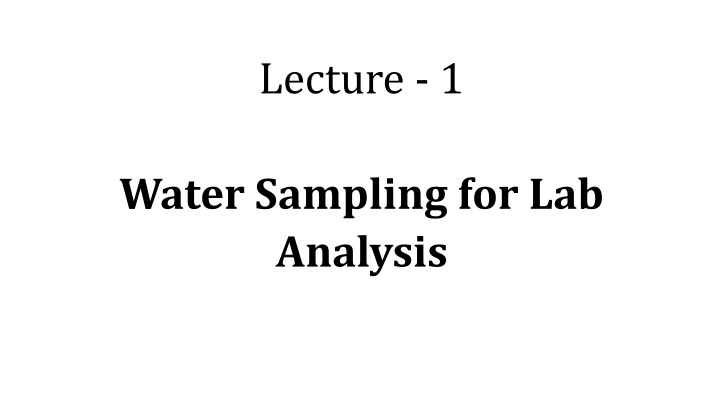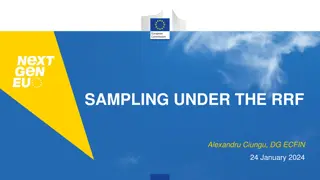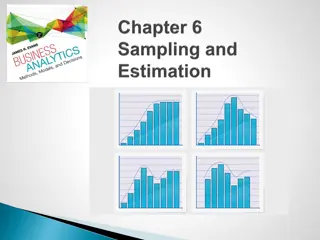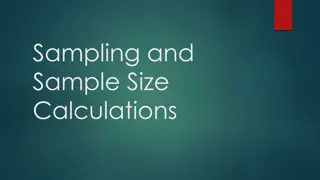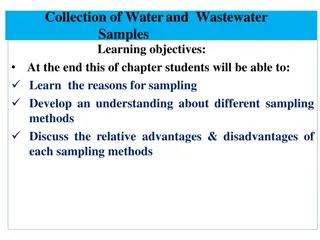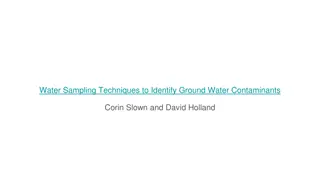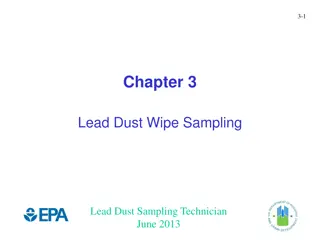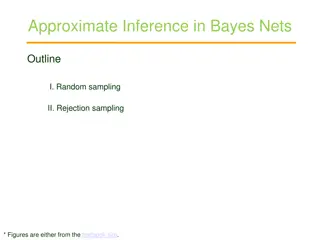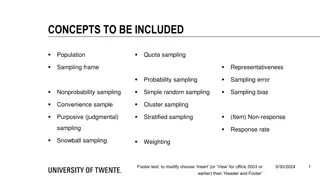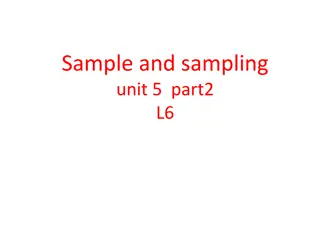Water Sampling for Lab Analysis
Water sampling for lab analysis plays a crucial role in assessing water quality and understanding the impact of human activities on sustainability. Proper sampling techniques are essential to ensure accurate representation of the material being analyzed, highlighting the importance of meeting sampling program requirements, handling samples carefully, and using clean equipment and containers.
Download Presentation

Please find below an Image/Link to download the presentation.
The content on the website is provided AS IS for your information and personal use only. It may not be sold, licensed, or shared on other websites without obtaining consent from the author.If you encounter any issues during the download, it is possible that the publisher has removed the file from their server.
You are allowed to download the files provided on this website for personal or commercial use, subject to the condition that they are used lawfully. All files are the property of their respective owners.
The content on the website is provided AS IS for your information and personal use only. It may not be sold, licensed, or shared on other websites without obtaining consent from the author.
E N D
Presentation Transcript
Lecture - 1 Water Sampling for Lab Analysis
Main objective of water sampling: The main objective of sampling is to collect a portion of material small enough in volume to be transported conveniently and yet large enough for analytical purposes while still accurately representing the material being sampled.
Objectives of water sampling for lab analysis in detail: To use reliable and useful source for sample collection To determine the quality of nature in its natural state To assess the effect of human activities on water quality and its sustainability To keep under observations the sources and pathways of pollutants / contaminants
Requirements for Sampling: Meet the requirements of the sampling program. Handle the sample carefully so that it does not deteriorate or become contaminated or compromised before it is analyzed. Ensure sampling all equipment are clean and quality assured before use. Use sample containers that are clean and free of contaminants. Rinse the bag/bottle at least twice with the sample water prior to filling and closing.
Requirements for Sampling (contd.): Fill bag/bottle as full as possible. Half-filling leaves more room for oxygen which will promote degradation of your sample. If sampling a body of running water, point the mouth of the bag upstream and your hands downstream to avoid contamination.
Requirements for Sampling (contd.): If sampling from a water faucet, run the faucet for 1 minute before obtaining a sample. Make records of every sample collected and identify every bottle e.g., take notes and photographs, fill out tags, etc. Place the sample into appropriate, labeled containers. All samples must be preserved as soon as practically possible.
Sampling of Water for Analysis: A common cause of error in water quality analysis is improper sampling. The results of a water quality analysis of a sample show only what is in the sample. For the results to be meaningful, the sample must be representative i.e., it must contain essentially the same constituents as the body of water from which it was taken.
Sample Collection bottles, Size and Materials: The methods that will be followed will determine the type of bottles used. For example, Samples for metals analyses are usually collected in plastic bottles Analyses for volatile organics and pesticides are collected in glass containers. Bottles used to collect samples for bacteria should be sterilized. Certain analysis like volatile organics and radon require vials that are to be filled leaving no head space, which keeps these analytes dissolved in the water preventing them from escaping into the air.
Sample Collection bottles, Size and Materials (contd.): Additionally, some analyses require samples to be collected in amber colored bottles. These darker bottles are for analytes (polypropylene and LDPE) that break-down in sunlight, which helps keep these contaminants from breaking down while in transit to the laboratory for analysis. The size of the container is important to ensure enough sample to run the analysis needed.
Figure: Polypropylene Figure: Schematic of LDPE branching structure
